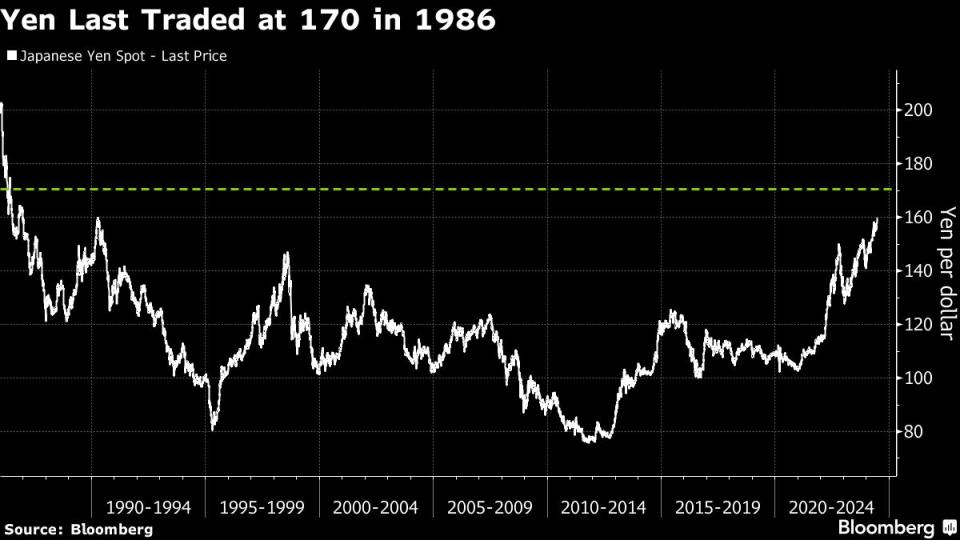Forget 160, Traders See Yen Slumping as Far as 170 This Time

(Bloomberg) -- The yen is at risk of sliding to levels last seen in 1986, with bearish traders unfazed by the specter of government intervention to bolster Japan’s embattled currency.
Most Read from Bloomberg
YouTuber Dr Disrespect Was Allegedly Kicked Off Twitch for Messaging Minor
Nvidia Rout Takes Breather as Traders Scour Charts for Support
BuzzFeed Struggles to Sell Owner of Hit YouTube Show ‘Hot Ones’
Jain Global Raises $5.3 Billion, Secures Cash From Abu Dhabi
Israel Court Calls Ultra-Orthodox Men Into Army as Crisis Brews
A slump as far as 170 per dollar — some 10 yen from current levels — is possible amid continued selling of the currency in favor of the higher-yielding greenback, according to Sumitomo Mitsui DS Asset Management Co. and Mizuho Bank Ltd.
Investors see few catalysts right now, including potential yen purchases by Japan, that would be powerful enough to reverse the momentum that’s sent the yen down almost 12% this year. Market moves since early May underscore this point, with the yen pretty much back where it started following a record ¥9.8 trillion ($61.4 billion) foray into the market.
“There’s potential for dollar-yen to get to 170 relatively quickly,” said Nick Twidale of ATFX Global Markets, who has traded Japan’s currency for a quarter of a century. “Short-term intervention just does not work.”
At the heart of bearish yen bets is Japan’s yawning interest-rate gulf with the US. The Federal Reserve has yet to cut interest rates, with the upper bound of its benchmark at 5.5% while that of the BOJ is barely above zero. The same issue applies relative to Europe, with the yen edging toward a record low versus the euro.
That’s helped make the yen, which is the world’s third-most-traded currency, a prime target to sell against everything from the higher-yielding dollar to the euro to emerging-market counterparts.
While Japan’s top currency official Masato Kanda warned on Monday that authorities are standing ready to intervene 24 hours a day if necessary, his words had little impact.
The yen was fractionally stronger at 159.46 versus the dollar at 8 a.m. in New York on Tuesday, within range of the 160.17 level set on April 29 when Japan is suspected to have made the first of two recent interventions. The second appears to have been on May 1.
Tuesday’s small respite doesn’t change the bigger picture, with the path of least resistance being for more weakness in the yen, said Carol Kong, a currency strategist at Commonwealth Bank of Australia.
What Bloomberg Strategists Say ...
“With the Federal Reserve in no rush to lower interest rates, traders can see all the emphasis for a yen turnaround sits with Japanese authorities and for now their words are doing little to convince traders to change direction.”
Mark Cranfield, Markets Live strategist
To read more, click here.
Japan’s currency may strengthen beyond 150 per dollar should officials intervene, but “in the long term, the yen will continue to weaken toward 170,” said Shinji Kunibe, lead portfolio manager at Sumitomo Mitsui DS Asset Management.
“It’s really tempting fate to say ‘you can’t do 170’,” said Vishnu Varathan, head of economics and strategy at Mizuho Bank Ltd. in Singapore. “Is it desirable? No. Is it ruled out as a possibility? Unfortunately not.”
Asset managers are also downbeat. They piled into bets against the yen in the week ended June 18, marking the most bearish positioning in data going back to 2006, according to Commodity Futures Trading Commission figures released on Monday. Hedge funds also added to bearish yen bets, staying near recent record, the data show.
To be sure, not all observers are negative on the yen. Taro Kimura, senior Japan economist for Bloomberg Economics, wrote that “the yen is more likely to strengthen than to weaken in coming months as yield differentials turn more favorable.” His view depends on the BOJ hiking rates twice and Fed cutting twice by the end of the year.
For now though, investors are bracing for more immediate market volatility should Tokyo step into markets again.
There’s risk of intervention should the currency move “more than one yen per day for several days,” said Hiroshi Namioka, chief strategist at T&D Asset Management Co.
The market also appears to be “less afraid” of intervention now given the steady upside pressure on dollar-yen since officials last acted, according to Alvin Tan, head of Asia FX strategy at Royal Bank of Canada in Singapore.
“I remain doubtful that there is a firm red line for Tokyo on dollar-yen, and new highs above 160 beckon,” wrote Tan, who was the top dollar-yen forecaster in the first quarter, according to Bloomberg-compiled data.
--With assistance from Daisuke Sakai, Anya Andrianova and Carter Johnson.
(Updates pricing throughout.)
Most Read from Bloomberg Businessweek
How Jeff Yass Became One of the Most Influential Billionaires in the 2024 Election
Why BYD’s Wang Chuanfu Could Be China’s Version of Henry Ford
Independence Without Accountability: The Fed’s Great Inflation Fail
©2024 Bloomberg L.P.

 Yahoo Finance
Yahoo Finance 